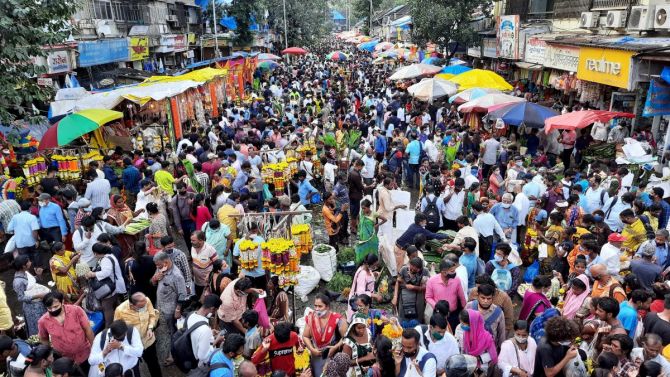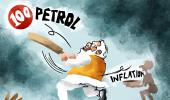'When you plot the growth, -- 7.5 per cent for Q2, 0.4 per cent for Q3, 1.6 per cent for Q4 and 20.1 per cent for Q1 now -- all you see is a 'V'.'
'You don't see any other alphabet in the shape there.'

If the third Covid wave is muted, there's likely to be a growth in consumption like in the January-March quarter, Chief Economic Adviser Krishnamurthy Subramanian tells Shrimi Choudhary.
Demand is still subdued at 55.8 per cent of GDP against 56.9 per cent a year ago and 59.2 per cent in Q4 of FY21. When do you expect demand recovery in the economy?
Consumption in Q1 was impacted by the restrictions, especially in retail activity. For most of May and June, shopping malls, shops, and bazaars were closed. The mobility was restricted in many states.
As a result, even if people wanted to consume, the lack of supply impacted consumption. Despite the presence of these restrictions, consumption grew at about 20 per cent, which is noteworthy.
Last year and Q1 of this year, the impact is primarily because of the restrictions required by the pandemic; last year, Q1 was impacted by the first wave of the pandemic and this year Q1 growth was lower than otherwise because of the second wave-induced restrictions.
As the restrictions were placed at the state level in Q1 this year, the recovery has continued.
In fact, if the second wave had not happened and mobility indicators had continued to rise the way they were doing in Q4, the numbers would have been far higher.
Therefore, when you assess recovery, you have to take the economic fundamentals into account, which is reflecting in growth number despite the intense second wave.
But as the restrictions have been lifted, the demand should come back. And since vaccination is proceeding strongly, contact intensive sectors too will revive.
Do you think the momentum will continue? Economists have cautioned that the low base effect is set to wear off in the coming quarters.
All high-frequency indicators' movement is much better in the second quarter (July-August) mainly because restrictions have been lifted significantly.
Despite the devastating second wave, the consumption activity grew by 20.1 per cent -- that too, despite the state-level restrictions.
It's not just enough to say that this is happening due to a low base. It's happening even though we had such an intense second wave.
As we saw in Q2, Q3 and Q4 of FY21, when the pandemic was slightly muted, the consumption had ramped up, and this time around, we should expect the same.
The growth is down 17 per cent sequentially and more than 9 per cent from Q1 of 2019-2020. Can we really say we are on a robust growth path?
This recovery has happened, despite an intense second wave. If you look at the Google mobility indicators, they started falling April onwards, and recovered back to the previous levels only in mid-July.
So the entire Q1, both retail and grocery activity indicators were significantly down, and as they peaked in mid-May, they were actually 70 per cent down compared to the March 31 level.
So, despite significant restrictions at the state level, the consumption had grown 20 per cent and so has investment by 55 per cent, of course from a lower base.
The decline and the subsequent recovery was not reflecting anything about the fundamentals of the economy. It is only reflecting the economic restrictions that were placed or removed.
The restrictions in Q1 last year led to the decline, the recovery since then in Q2, Q3 and Q4 reflected the reduction of the restrictions.
Now, the continued recovery in Q1 this year has manifested due to the restrictions at the state level instead of the national level.
Experts say this is a K-shaped recovery, with informal sector and small companies not doing well. Is that a correct assessment?
The GDP growth has clearly gone up after declining 24.4 per cent. When you plot the growth, -- 7.5 per cent for Q2, 0.4 per cent for Q3, 1.6 per cent for Q4 and 20.1 per cent for Q1 now -- all you see is a 'V'. You don't see any other alphabet in the shape there.
Last year, around this time, when I had said this, no one believed it. Now, when all the macroeconomic numbers have indeed manifested, people have changed the goalpost and question about recovery in sectors....
Some sectors, particularly the contact-sensitive ones, have been most impacted for sure. For instance, after the global financial crisis, manufacturing got impacted far more than services. Therefore, I think that kind of difference always persists.
But at the macro-economic level, which is captured by GDP growth, the performance has been a V-shaped one.













 © 2025
© 2025